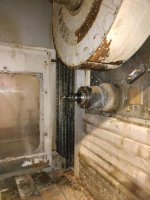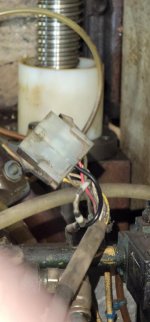countryguy
Hot Rolled
- Joined
- Jul 29, 2014
- Location
- Mich, USA
hi D. HEck.. did you see this thread has over 15K in views? wow.
yep wild-leg is also called the Manufactured leg. If you are running everything and have no issues in the house, shop, etc- should be good to go... but I'll toss some things out that we had to do here.
On the rear hookup taps on the Haas here is what I do just to get a sense of whats going on. I have a Fluke Digimeter w/ min/max button. Even the cheap digitals from HF have that now as well. As you leave it on.. it will snap the lowest AC voltage seen and display it.
Some backdrop- When I noted to put the wild-leg on the center leg on the other post. When we did that we later found that someone had twisted that down thru the breaker individual wire path. By that I mean wires run thru the master switch contactor, to another pull in type, then down to the transformer taps hookups. So someone had inadvertantly move a wire around with another. Ohm check that if you're of the opinion (as some posters are here on Haas w/ RPC's for the wild-leg placement).
Once the machine is powered up, I put the meter in MIN mode. Place the leads on the single-phase taps with alligator clip-ons for the meter (many come w/ these) and leave it on and run some loads. Start firing up the speeds and some high speed spindle & test loads with the compressor cranking, the lights on et. Conditions you would run a job on. See what your minimum AC single phase hits.
Then I had to move 1 of the leads to the wild-leg, place on MIN and run again. Watch the min voltage here.
Why: on my side... the 10K pole Xformer sagged terribly on high loading and in Summer months. 213AC type sags. And the RPC would sag to say 225 (guessing.. dont' really remember). With this condition of the 'Power company' not able to supply the load I needed, the Haas would Alarm w/ a phase out of tolerance because the generated leg was 10% different. (something like that. it's in my other posts).
We also observed that while the PowerCo power was no-load at 239-240AC, the RPC was putting 259AC w/ no load and stayed on the high end. So I had two issues here. A higher line RPC value, and a sagging power company issue. Calling the RPC MFR was rather useless. a CNC RPC that did not keep tolerance to the main line is something for another day. This was solved by a) the new pole 25K Xformer (which is still not great but errors mostly subsided) AND b) added the phase-a-matic voltage conditioner which is basically just a reference transformer to take the 260 wildleg and moved it down to 245AC. (it's all on their site) I now ended up w/ 240 AC single phase and 245 RPC generated leg. This is far closer to each other to stem any phase mismatch errors when under loads and summer neighbor AC load issues and the new transformer loading is similar and close to the RPB sag. in the end- Balanced!
The 240 single phase coming in. If your in a residential place? 50K transformer, 20K? My last place was a 50KV Xformer running 4 to 5 houses w/ underground lines. This place is rural, far spread, and had a dinky 10KV pole xformer for two homes with shops. (neighbor has a biz too). It is all related. a 400amp panel in your shop is super... but the pole probably does not supply that type of amperage load anyway? Find find your pole and see what the Xformer (xformer = transformer) rating is is just something to know IMO.
yep wild-leg is also called the Manufactured leg. If you are running everything and have no issues in the house, shop, etc- should be good to go... but I'll toss some things out that we had to do here.
On the rear hookup taps on the Haas here is what I do just to get a sense of whats going on. I have a Fluke Digimeter w/ min/max button. Even the cheap digitals from HF have that now as well. As you leave it on.. it will snap the lowest AC voltage seen and display it.
Some backdrop- When I noted to put the wild-leg on the center leg on the other post. When we did that we later found that someone had twisted that down thru the breaker individual wire path. By that I mean wires run thru the master switch contactor, to another pull in type, then down to the transformer taps hookups. So someone had inadvertantly move a wire around with another. Ohm check that if you're of the opinion (as some posters are here on Haas w/ RPC's for the wild-leg placement).
Once the machine is powered up, I put the meter in MIN mode. Place the leads on the single-phase taps with alligator clip-ons for the meter (many come w/ these) and leave it on and run some loads. Start firing up the speeds and some high speed spindle & test loads with the compressor cranking, the lights on et. Conditions you would run a job on. See what your minimum AC single phase hits.
Then I had to move 1 of the leads to the wild-leg, place on MIN and run again. Watch the min voltage here.
Why: on my side... the 10K pole Xformer sagged terribly on high loading and in Summer months. 213AC type sags. And the RPC would sag to say 225 (guessing.. dont' really remember). With this condition of the 'Power company' not able to supply the load I needed, the Haas would Alarm w/ a phase out of tolerance because the generated leg was 10% different. (something like that. it's in my other posts).
We also observed that while the PowerCo power was no-load at 239-240AC, the RPC was putting 259AC w/ no load and stayed on the high end. So I had two issues here. A higher line RPC value, and a sagging power company issue. Calling the RPC MFR was rather useless. a CNC RPC that did not keep tolerance to the main line is something for another day. This was solved by a) the new pole 25K Xformer (which is still not great but errors mostly subsided) AND b) added the phase-a-matic voltage conditioner which is basically just a reference transformer to take the 260 wildleg and moved it down to 245AC. (it's all on their site) I now ended up w/ 240 AC single phase and 245 RPC generated leg. This is far closer to each other to stem any phase mismatch errors when under loads and summer neighbor AC load issues and the new transformer loading is similar and close to the RPB sag. in the end- Balanced!
The 240 single phase coming in. If your in a residential place? 50K transformer, 20K? My last place was a 50KV Xformer running 4 to 5 houses w/ underground lines. This place is rural, far spread, and had a dinky 10KV pole xformer for two homes with shops. (neighbor has a biz too). It is all related. a 400amp panel in your shop is super... but the pole probably does not supply that type of amperage load anyway? Find find your pole and see what the Xformer (xformer = transformer) rating is is just something to know IMO.
I ended up going with the american rotary adx 60, I upgraded the whole house to a 400 amp single phase panel, and put in a 200 amp panel in the garage. im running the phase converter off of a 200 amp breaker right at the top below the main breaker for the sub panel, so the resistance should be minimal. I was talking to the haas guy while he was servicing our office mill at my work, and he said the motors are actually rated at 15hp, and have a 30hp drive, so the 60hp phase converter is likely overkill despite the machine having the 30hp branding, and the American rotary recommendation of double the horsepower. My compressor only draws about 15 amps,from the single phase panel, if it causes an issue I can run a dedicated line from the main panel. My main concern is the incoming lines from the pole are a lot thinner than what I used to make the run for the subpanel, so if anything that will be where the voltage drops.
thats ma' story! Hope is helps. It's all soblable usually, that is the good news.
By wild leg I assume you mean what American rotary calls the manufactured leg. I know what the wild leg is on standard 3 phase, I don't know the terminology for the 3 phase legs that comes out of rotary.
I took the y axis ball screw out and its quite pitted, but its not that difficult to remove, so im not going to wait until I get a new one to put the machine back together. I also got a sand blaster and a parts cleaner so I can repaint all the rusted sheet metal.
Last edited:









